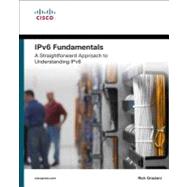
Rick Graziani teaches computer science and computer networking courses at Cabrillo College in Aptos, California. Prior to teaching, he worked in the information technology field for Santa Cruz Operation, Tandem Computers, and Lockheed Missiles and Space Corporation. He holds an M.A. in computer science and systems theory from California State University Monterey Bay. Rick also does consulting work for Cisco Systems. When he is not working, he is most likely surfing at one of his favorite Santa Cruz surf breaks.
Introduction xvi
Part I: Background Justification and Perspective for IPv6
Chapter 1 Introduction to IPv6 1
IPv4 1
Early Years of the Internet 2
IPv5 5
History of IPv6 5
Benefits of IPv6 7
IPv6: When? 8
IPv4 Address Depletion 9
CIDR 10
NAT and Private Addresses 12
Exhaustion of IPv4 Address Space 15
Migrating to IPv6 17
Chapter 2 The IPv6 Protocol 23
IPv4 Header 23
IPv6 Header 27
Packet Analysis Using Wireshark 31
Extension Headers 33
Hop-by-Hop Options Extension Header 36
Routing Extension Header 38
Fragment Extension Header 39
IPsec: AH and ESP Extension Headers 40
IPsec 40
Transport and Tunnel Modes 41
Encapsulating Security Payload (ESP) Extension Header 42
Authentication Header (AH) Extension Header 43
Destination Options Extension Header 45
No Next Header 46
Comparing IPv4 and IPv6 46
IPv4 and IPv6 Header Comparisons 46
Other Differences 47
Larger Maximum Transmission Unit (MTU) 47
User Datagram Protocol (UDP) 48
Fragmentation 48
Part II: IPv6: The Protocol
Chapter 3 IPv6 Addressing 51
Hexadecimal Number System 51
Representation of IPv6 Addresses 54
Rule 1: Omission of Leading 0s 55
Rule 2: Omission of all-0s hextets 57
Combining Rule 1 and Rule 2 58
Prefix Notation 60
Brief Look at IPv6 Address Types 63
Unicast Addresses 63
Anycast Addresses 64
Multicast Addresses 64
Structure of a Global Unicast Address 64
Global Routing Prefix 65
Subnet ID 65
Interface ID 65
3-1-4 Rule 65
Putting It Together 67
Subnetting 71
Extending the Subnet Prefix 73
Subnetting on a Nibble Boundary 75
Subnetting Within a Nibble 76
Limiting the Interface ID Space 77
Chapter 4 IPv6 Address Types 81
IPv6 Address Space 82
Unicast Address 84
Global Unicast Address 85
Manual Global Unicast Configuration 87
Dynamic Configuration 99
Link-local Unicast 107
Dynamic Link-local Address: EUI-64 109
Randomly Generated Interface IDs 110
Static Link-local Address 111
Link-local Addresses and Duplicate Address Detection 114
Link-local Addresses and Default Gateways 115
Isolated Link-local Address 116
Loopback Address 116
Unspecified Address 118
Unique Local Address 119
IPv4 Embedded Address 121
IPv4-Compatible IPv6 Addresses 122
IPv4-Mapped IPv6 Addresses 123
Multicast 124
Assigned Multicast Addresses 127
Solicited-Node Multicast Addresses 130
Anycast Address 132
Chapter 5 ICMPv6 and Neighbor Discovery Protocol 139
General Message Format 140
ICMP Error Messages 144
Destination Unreachable 145
Packet Too Big 146
Path MTU Discovery 147
Time Exceeded 148
Parameter Problem 149
ICMP Informational Messages 149
Echo Request and Echo Reply 150
Pinging a Global Unicast Address 151
Pinging a Link-local Address 153
Multicast Listener Discovery 155
Neighbor Discovery Protocol 159
Router Solicitation and Router Advertisement Messages 160
Neighbor Solicitation and Neighbor Advertisement Messages 169
Neighbor Cache and Destination Cache 172
Address Resolution 174
Duplicate Address Detection 180
Neighbor Unreachability Detection 182
Stateless Address Autoconfiguration 182
Redirect Messages 184
Chapter 6 IPv6 Configuration 191
Configuring Global Unicast Addresses 193
Configuring Link-local Addresses 195
The ipv6 enable Command 199
Configuring a Global Unicast Address with the EUI-64 Option 200
Removing an IPv6 Address 202
Enabling IPv6 Packet Forwarding and ND Router Advertisements 203
Neighbor Cache 205
Tuning Neighbor Discovery Parameters 207
Final Configurations 213
IPv6 Access Control Lists 216
Denying Access from FACE:C0DE to CAFE 217
Permitting Local Telnet Access 221
Part III: Routing IPv6
Chapter 7 Introduction to Routing IPv6 227
IPv6 Routing Table 228
Code: Connected 231
Code: Local 233
Comparing IPv6 and IPv4 Routing Tables 234
Configuring IPv6 Static Routes 237
Changing the Administrative Distance 247
Final Configurations and Verification 249
CEF for IPv6 251
Chapter 8 IPv6 IGP Routing Protocols 255
RIPng for IPv6 257
Comparing RIPng for IPv6 and RIPv2 257
Configuring RIPng on Cisco Routers 259
Verifying RIPng 264
EIGRP for IPv6 272
Comparing EIGRP for IPv4 and EIGRP for IPv6 272
Configuring EIGRP for IPv6 273
Verifying EIGRP for IPv6 278
OSPFv3 286
Comparing OSPFv2 and OSPFv3 287
Configuring OSPFv3 289
Verifying OSPFv3 293
Chapter 9 DHCPv6 (Dynamic Host Configuration Protocol version 6) 303
DHCPv6 Services 303
DHCPv6 Terminology, Multicast Addresses, and Message Types 306
DHCPv6 Communications 309
Configuring Stateless DHCPv6 313
Rapid Commit Option 318
Configuring the Rapid Commit Option 319
Relay Agent Communications 320
Configuring the Relay Agent 322
Other Upper-Layer Protocols 323
DNS 323
DNS Query and Response 326
TCP and UDP 328
Chapter 10 Dual-Stack and Tunneling 333
Dual-Stack 334
IPv6 Address Format in URL Syntax 336
Configuring a Dual-Stack Network 337
Tunneling 344
Manual Tunnels 349
6to4 Tunnels 356
6to4 Tunnels and Loopback Interfaces 364
ISATAP 365
Other Tunneling Technologies 373
Chapter 11 Network Address Translation IPv6 to IPv4 (NAT64) 377
NAT64 378
Traffic Initiated from IPv6-only Clients to IPv4-only Servers 379
Configuration 383
Traffic Initiated from IPv4-only Clients to IPv6-only Servers 387
NAT-PT: Network Address Translation – Protocol Translation 389
Application Level Gateway 390
Using NAT-PT 391
Static NAT-PT 394
Dynamic NAT-PT 399
Other Translation Techniques 402
9781587143137, TOC, 9/18/2012
The New copy of this book will include any supplemental materials advertised. Please check the title of the book to determine if it should include any access cards, study guides, lab manuals, CDs, etc.
The Used, Rental and eBook copies of this book are not guaranteed to include any supplemental materials. Typically, only the book itself is included. This is true even if the title states it includes any access cards, study guides, lab manuals, CDs, etc.